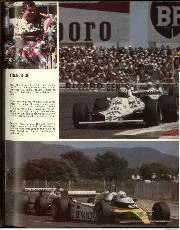
1980 French Grand Prix in pictures
FRENCH GP Top: Alan Jones, hopefully heading for the World Championship, after a well deserved win at Paul Ricard, where he drove a planned and very determined race. Right: The…
iLLFETTES WIN TWO ITALIAN RACES FARINA AND BIONDETTI WIN THE COPPA CIANO AND THE COPPA ACERB°
EVER since they were so heavily defeated at Tripoli by the brandnew Mercedes-Benz, the Alfa Corse have been known to be carrying on intensive tuning and modification of their eight-cylinder 1,500 c.c. cars. The results of this work were seen last month when they scored victories in three successive week-ends at Leghorn, Pescara and Berne. The latter race is described on another page. The Coppa Ciano at Leghorn was an ail-Italian affair. It had been hoped that the Germans might be induced to send their 1,500 c.c. Mercedes, in order to give the Italians an opportunity to take their revenge for Tripoli, which still rankles, but there seems to be little likelihood of these cars being seen in action again this year. As it was, three Alfa-Romeos did battle with seven Maseratis, and a very good battle it was. Farina went into the lead immediately, and stayed there till the end, making the fastest lap en route at 90.8 m.p.h. But Alfa-Romeos, as a make, did not have it all their own way by any means. Cortese and Taruffi had a couple of the latest Maseratis at their disposal, and had a great dog-fight with the other Alfettes. Biondetti was doing well until his Alfette gave trouble, whereupon Pintacuda on the third car was
stopped and his machine handed over to Biondetti. The latter’s car was then repaired sufficiently for it to be taken over by the reserve man, Seven, as for some reason or other Pintacuda did not care to carry on. In the end Farina won by a lap from Cortese (Maserati), at 88.32 m.p.h. with the Pintacuda-Biondetti Alfa-Romeo two laps astern. Then came Taruffi (Maserati) a lap behind, with the Biondetti-Severi Alfa-Romeo four laps farther back. All of which sounds rather complicated, as indeed it was. Engine mortality was particularly heavy, because the course is fast and Italian drivers have little mercy On their cars when engaged in a keen race—and who blames them ? The next week-end, at Pescara, it was Biondetti’s turn. But first of all a tragedy must be recorded. During the practice, Nando Aldrighetti was trapped in his Alfa-Romeo when it caught fire at speed, and was so badly burnt that he died as a result of his injuries. Aldrighetti was better known as a motorcyclist, than as a racing motorist, and his
death was keenly felt in Italy. He is the second member of the Alfa Corse team to meet his death this year. This time there was no qualification about the Alfa win, for these cars took the first four places, with the Maseratis nowhere. Biondetti’s speed for the ‘224mile race was 83.3 m.p.h., which is almost identical with Villoresi’s lap-record last year. This year the fastest lap was made by Farina in ii mins. 6.5 sees. at a speed of 86.5 m.p.h. Biondetti won with great ease, being over two minutes ahead of Pintacuda, who led Farina by 19 seconds,
with Seven i fourth. The only British driver in the race was A. C. Pollock, who finished fifth with his E.R.A. nearly nine minutes behind the winner.
The usual timed kilometre was held along the straight which runs parallel to the sea, and as this is approached by a downhill stretch, the cars are really giving of their best. Fastest of all was Villoresi’s Maserati, which clocked 147.147 m.p.h., but it is rather significant that he did not finish the race. The trouble with Pescara, of course, is that it is easy to over-rev, along this straight with gearratios that give the best acceleration on the winding uphill section. A race was also held for “cadet ” drivers, the winner being Barbieri on a
Maserati. at 75.49 m.p.h. In this the second fatal accident of the meeting took place when Guiseppe Lami overturned his Maserati and was instantly killed.